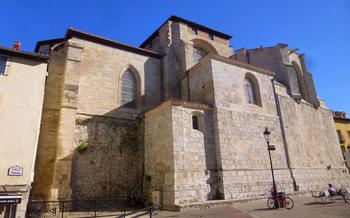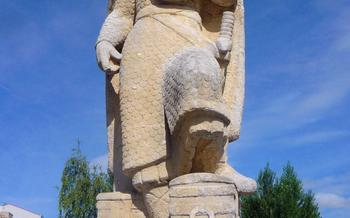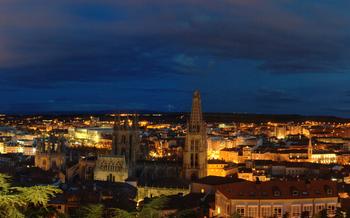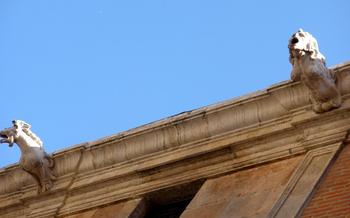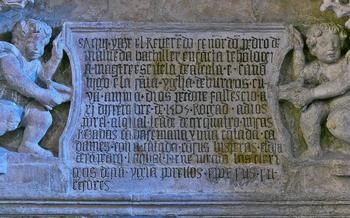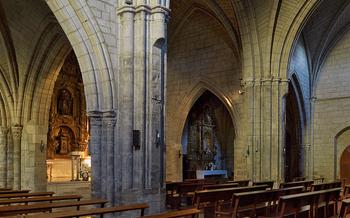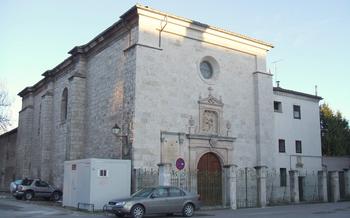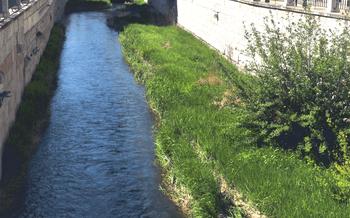
Molino de la Merced
- Burgos' Hidden Gem: Unveiling the Molino de la Merced
- A Journey Through Time: Exploring the Mill's History
- Marvels of Engineering: Delving into the Mill's Design
- A Mill with Many Faces: The Mill's Changing Roles
- Art and Nature Converge: The Mill's Picturesque Surroundings
- A Mill Reborn: The Restoration Project
- Interactive Experiences: Engaging with the Mill's Heritage
- Local Delights: Savoring the Flavors of Burgos
- Cultural Events and Festivals: Celebrating Burgos' Heritage
- Beyond the Mill: Exploring Burgos' Other Treasures
- Practical Information: Planning Your Visit to the Molino de la Merced
- Insider Perspectives: Interviews with Locals and Experts
- Insider Tip: Hidden Gems Around the Mill
Burgos' Hidden Gem: Unveiling the Molino de la Merced
Nestled along the banks of the Arlanzón River, the Molino de la Merced stands as a testament to Burgos' rich history and architectural prowess. This ancient watermill, dating back to the 16th century, is a captivating blend of functionality and beauty, embodying the ingenuity and craftsmanship of its era. Its enduring presence has earned it the status of a beloved landmark, attracting visitors from far and wide who seek to unravel its secrets and immerse themselves in its timeless charm.
As you approach the mill, its imposing structure commands attention, hinting at the stories it holds within. Its sturdy stone walls, weathered by time, bear witness to centuries of tireless operation, while the gentle murmur of the river creates a serene ambiance, inviting you to step back in time and explore the wonders that await.
A Journey Through Time: Exploring the Mill's History
The Molino de la Merced, with its impressive structure and rich history, has stood the test of time, becoming an integral part of Burgos' cultural heritage. The mill's origins date back to the 12th century, when it was constructed by the Knights Hospitaller, a religious order known for their dedication to charitable work and protecting pilgrims. Initially, the mill served as a flour mill, grinding wheat into flour for the local community. Its strategic location on the banks of the Arlanzón River provided a reliable source of water power, ensuring the mill's efficient operation.
Over the centuries, the mill played a pivotal role in the local economy. Burgos, a bustling center of commerce and trade, relied on the mill to produce flour for its growing population. The mill's success and significance were deeply intertwined with the city's prosperity. Historical records reveal that the mill underwent several renovations and expansions to meet the increasing demand for flour. These modifications not only enhanced its functionality but also contributed to the mill's architectural evolution, showcasing various construction techniques and styles.
Beyond its practical purpose, the Molino de la Merced witnessed numerous historical events that shaped the city's identity. During the Middle Ages, it served as a refuge for pilgrims seeking shelter and sustenance along the Camino de Santiago, a renowned pilgrimage route. The mill's association with the Knights Hospitaller further enriched its history, as they provided assistance and protection to travelers. It is said that the mill's location on the outskirts of Burgos allowed it to play a strategic role in defending the city from invaders.
The mill's enduring legacy is a testament to its resilience and adaptability. From its humble beginnings as a flour mill to its current status as a cultural landmark, the Molino de la Merced stands as a symbol of Burgos' rich history and unwavering spirit.
Marvels of Engineering: Delving into the Mill's Design
The Molino de la Merced stands as a testament to human ingenuity and engineering prowess. Its structure, meticulously crafted from local materials, showcases a blend of functionality and elegance. The mill's foundation, laid deep into the riverbed, ensures stability and resilience against the relentless force of the river. Its thick stone walls, weathered by centuries of exposure, bear witness to the mill's enduring strength.
At the heart of the mill lies its ingenious waterwheel, a marvel of simplicity and efficiency. Meticulously designed to harness the river's energy, the wheel rotates gracefully, capturing the power of the flowing water and converting it into motion. The mill's intricate system of gears and shafts transmits this motion throughout the structure, powering the machinery that grinds grain into flour.
The mill's design incorporates several innovative features that enhance its performance and efficiency. A carefully engineered system of sluice gates allows for precise control of the water flow, ensuring optimal power generation. The mill's unique positioning, nestled amidst natural rock formations, provides additional stability and protection from the elements.
As we marvel at the Molino de la Merced's intricate design, we can't help but appreciate the ingenuity of its creators. Their deep understanding of hydraulics and mechanics allowed them to craft a structure that has stood the test of time, serving as a reminder of human innovation and the enduring power of water.
A Mill with Many Faces: The Mill's Changing Roles
Over the centuries, the Molino de la Merced has undergone a remarkable transformation, adapting to the changing needs and circumstances of Burgos. Initially conceived as a functioning mill, it played a crucial role in the local economy, grinding grain to produce flour for bread and other essential goods. Its strategic location on the banks of the Arlanzón River provided a reliable source of water power, enabling the mill to operate efficiently.
As time progressed, the mill's significance diminished with the advent of modern milling technologies. It gradually fell into disuse and was eventually abandoned, left to decay and crumble. However, its historical and cultural value was not forgotten. In the late 20th century, a concerted effort was made to preserve and restore the mill to its former glory.
The restoration project was a labor of love, undertaken by passionate individuals who recognized the importance of preserving Burgos' heritage. Through meticulous attention to detail and the use of traditional construction techniques, the mill was brought back to life. The restored mill now stands as a testament to the ingenuity and resilience of the people of Burgos, symbolizing the city's rich history and connection to its past.
Today, the Molino de la Merced stands as a proud cultural landmark, inviting visitors to explore its fascinating story. It serves as a reminder of the city's industrial heritage and the importance of preserving historical landmarks for future generations.
Art and Nature Converge: The Mill's Picturesque Surroundings
The Molino de la Merced is not merely a historical monument but also a picturesque masterpiece nestled amidst nature's embrace. The mill's stunning natural setting enhances its allure, creating a harmonious blend of art and nature. The surrounding landscape is a canvas painted with vibrant hues, where verdant meadows meet the tranquil waters of the river. The mill stands as a testament to the delicate balance between human ingenuity and the natural world.
Local flora and fauna flourish in abundance around the mill, adding to its enchanting ambiance. The air is alive with the melodious chirping of birds, while the gentle rustling of leaves creates a soothing symphony. Visitors can spot a variety of wildflowers, each a delicate work of art in its own right. The mill's idyllic surroundings have long inspired local artists, who have captured its essence through paintings, photographs, and literary works. The mill serves as a muse, providing endless creative possibilities for those who seek inspiration in nature's beauty.
A Mill Reborn: The Restoration Project
The Molino de la Merced, a testament to Burgos' rich history, faced the inevitable ravages of time and neglect. However, in a remarkable turn of events, a dedicated team of preservationists, fueled by a deep appreciation for the mill's significance, embarked on an ambitious restoration project. Their goal was not merely to restore the mill to its former glory but to breathe new life into its aging structure, ensuring its legacy for generations to come.
The restoration process was a labor of love, requiring meticulous attention to detail and a deep understanding of the mill's original design. Every stone, every beam, and every intricate mechanism was carefully examined, repaired, or replaced using traditional techniques and materials. The team worked tirelessly to strike a delicate balance between preserving the mill's authenticity and incorporating modern elements that would enhance its functionality and accessibility.
The challenges were numerous, but the team's determination never wavered. They grappled with the effects of time and weather, sourcing materials that matched the mill's original appearance while meeting modern safety standards. They also had to find innovative solutions to address structural issues and ensure the mill's long-term stability.
Through perseverance and collaboration, the restoration team successfully brought the Molino de la Merced back to life. The mill's once-crumbling walls now stand tall, its machinery gleams with a renewed shine, and its surroundings have been transformed into a vibrant public space. The project serves as a shining example of preserving historical landmarks while adapting them to the needs of the present, ensuring their continued relevance and enjoyment for future generations.
Interactive Experiences: Engaging with the Mill's Heritage
The Molino de la Merced offers a range of interactive exhibits and displays that bring its history and significance to life. Visitors can step into the shoes of a miller and experience the process of grinding grain using traditional methods. Hands-on exhibits allow visitors to explore the mill's machinery and learn about the science behind its operation.
Educational workshops and activities are also available, providing an immersive learning experience for visitors of all ages. These workshops cover various topics, from the history of milling to the importance of water power. Participants can get their hands dirty and engage in activities such as grinding flour, making bread, and creating their own paper using traditional techniques.
By offering these interactive experiences, the Molino de la Merced not only preserves its heritage but also fosters a deeper understanding and appreciation for the mill's role in the community. It encourages visitors to connect with the past and gain a hands-on experience of the processes that shaped the city's development.
Local Delights: Savoring the Flavors of Burgos
A visit to the Molino de la Merced offers not only a journey through history but also a culinary adventure. The Burgos region is renowned for its rich gastronomy, and the mill's surroundings are dotted with charming restaurants and cafes that showcase local flavors.
Indulge in traditional dishes such as the hearty "Olla Podrida," a slow-cooked stew made with chickpeas, meats, and vegetables. Savor the succulent flavors of "Lechazo Asado," a tender roasted lamb dish that is a specialty of the region. Don't miss the opportunity to try "Morcilla de Burgos," a unique blood sausage that is a local delicacy.
For a truly immersive experience, head to the nearby Mercado de Abastos, a bustling market where you can browse and sample fresh produce, artisanal cheeses, and cured meats. Engage with friendly vendors who will be delighted to share their knowledge of local culinary traditions.
Incorporate the flavors of Burgos into your mill visit by dining at the on-site restaurant, which offers a menu inspired by regional cuisine. Enjoy a leisurely meal while overlooking the picturesque mill and the surrounding landscape.
Whether you prefer a hearty Castilian feast or a light snack, the culinary delights of Burgos will leave you with a lasting impression. Embrace the opportunity to savor the local flavors and make your visit to the Molino de la Merced a truly memorable gastronomic experience.
Cultural Events and Festivals: Celebrating Burgos' Heritage
The Molino de la Merced is not just a historical landmark but also a vibrant cultural hub that hosts a variety of events and festivals throughout the year. These events offer a fantastic opportunity to immerse in the local culture and traditions of Burgos.
One of the highlights is the annual Medieval Market, held in the charming streets surrounding the mill. This lively event transports visitors back in time with its colorful stalls, traditional costumes, and medieval performances. Visitors can browse unique handicrafts, savor delicious local cuisine, and enjoy enchanting music and dance shows.
Another must-attend event is the Festival of San Lesmes, the patron saint of Burgos. This religious and cultural celebration features solemn processions, lively concerts, and traditional dances in honor of the saint. The streets come alive with music, laughter, and a sense of community as locals and visitors alike gather to celebrate.
For art enthusiasts, the International Art Festival showcases the works of local and international artists in various mediums, including painting, sculpture, and photography. This vibrant event offers a platform for emerging talents and established artists to share their creativity and engage with the public.
To experience the true essence of Burgos, be sure to plan your visit around one of these cultural events or festivals. Immerse yourself in the city's rich heritage, savor the local flavors, and create lasting memories that will make your trip to Burgos truly unforgettable.
Beyond the Mill: Exploring Burgos' Other Treasures
While the Molino de la Merced stands as a captivating attraction, Burgos boasts a wealth of other treasures waiting to be explored. Immerse yourself in the city's rich history and vibrant culture by venturing beyond the mill.
For a glimpse into Burgos' architectural heritage, visit the majestic Burgos Cathedral. This awe-inspiring masterpiece of Gothic architecture is a UNESCO World Heritage Site and a testament to the city's enduring faith. Explore its intricate details, marvel at its soaring spires, and soak in the spiritual atmosphere within.
Step into the realm of art at the Museo de Burgos, where a diverse collection of paintings, sculptures, and artifacts awaits. Discover works by renowned Spanish artists and admire the city's artistic legacy. Learn about the evolution of art in Burgos and gain insights into the creative spirit that thrives here.
To delve deeper into the local culture, visit the Museo Etnográfico Provincial, which showcases the traditions and customs of Burgos. Experience interactive exhibits that bring to life the region's unique heritage. Learn about traditional crafts, music, and dance, and gain a deeper understanding of the local way of life.
For a taste of Burgos' culinary delights, embark on a gastronomic adventure. Indulge in traditional dishes like morcilla de Burgos, a flavorful blood sausage, and asado de cordero, a succulent roast lamb. Sample local cheeses, such as the renowned Queso de Burgos, and tantalize your taste buds with the region's rich and diverse flavors.
With so much to see and experience, Burgos offers an unforgettable journey through history, art, culture, and gastronomy. Let the city's treasures captivate you, leaving you with lasting memories and a newfound appreciation for this vibrant and enchanting destination.
Practical Information: Planning Your Visit to the Molino de la Merced
To ensure a smooth and enjoyable visit to the Molino de la Merced, here are some practical details to keep in mind:
Admission Fees and Hours: - Entrance to the mill is free of charge, allowing visitors to explore its historical charm without any financial limitations. - Opening hours vary depending on the season. During the summer months (April to September), the mill is typically open from 10 am to 8 pm. In the winter months (October to March), it is open from 10 am to 6 pm.
Guided Tours: - Guided tours are available for those who want to delve deeper into the mill's history and significance. These tours are conducted by knowledgeable guides who can provide insightful commentary and answer any questions visitors may have. - It is advisable to book guided tours in advance, especially during peak tourist season, to avoid disappointment.
Photography Tips: - The mill's picturesque surroundings and unique architecture present ample opportunities for photography enthusiasts. - To capture the best shots, consider visiting during the golden hours (sunrise and sunset) when the natural light casts a warm glow on the mill and its surroundings. - Utilize a tripod to ensure stability and capture sharp images, especially in low-light conditions.
Accessibility: - The mill is wheelchair accessible, ensuring that visitors with disabilities can comfortably explore its premises. - Designated parking spaces for visitors with disabilities are available nearby, making it convenient for them to access the mill.
Accommodation and Transportation: - For those planning an extended stay in Burgos, there are numerous accommodation options to choose from, ranging from budget-friendly hostels to luxurious hotels. - Burgos is well-connected by public transportation, making it easy to get to the mill from various parts of the city. The closest bus stop is just a short walk away, and taxis are readily available.
Insider Perspectives: Interviews with Locals and Experts
To gain a deeper understanding of the Molino de la Merced and its significance, I had the privilege of interviewing several local historians, mill enthusiasts, and residents. Their insights and personal stories brought the mill's history to life, revealing its profound impact on the community.
Don Santiago, a local historian, shared fascinating tales of the mill's role in shaping Burgos' economy and culture. He described how the mill's flour was once a staple of the local diet and how its water power was used to power other industries, such as textile mills and tanneries.
Doña María, a lifelong resident of Burgos, recounted her childhood memories of playing near the mill. She recalled the excitement of watching the millers at work and the delicious smell of fresh bread baking in the air.
Señora Luisa, a mill enthusiast, spoke passionately about the mill's unique design and engineering. She explained how the mill's innovative waterwheel system allowed it to operate even in low water conditions, making it a reliable source of power for the city.
These interviews provided me with invaluable insights into the Molino de la Merced's rich history and its enduring significance to the people of Burgos. By sharing their stories and perspectives, these individuals helped me to create a more comprehensive and engaging narrative of this remarkable landmark.
Insider Tip: Hidden Gems Around the Mill
As you wander around the Molino de la Merced, keep an eye out for hidden gems and lesser-known attractions that might pique your curiosity. Venture beyond the main path and explore the surrounding area to discover secret spots that offer unique perspectives and experiences. One such hidden gem is a secluded viewpoint that overlooks the mill and the surrounding landscape, providing a breathtaking panorama that's perfect for capturing Insta-worthy shots.
Another must-visit spot is a small, unassuming cafe nestled in the heart of the mill's grounds. This hidden gem serves up delicious local cuisine and offers a tranquil ambiance, making it the perfect place to unwind and savor the flavors of Burgos.
For those seeking a more active experience, there are several hiking trails that lead to the mill, offering a chance to immerse yourself in the natural beauty of the region. As you hike along these trails, keep an eye out for historical landmarks, ancient ruins, and hidden waterfalls that add an element of adventure to your journey.
Remember, the best way to discover these hidden gems is to engage with locals and fellow travelers. Strike up conversations, ask for recommendations, and be open to exploring the unknown. With a little curiosity and a willingness to venture off the beaten path, you'll uncover the true magic of the Molino de la Merced and its surroundings.
